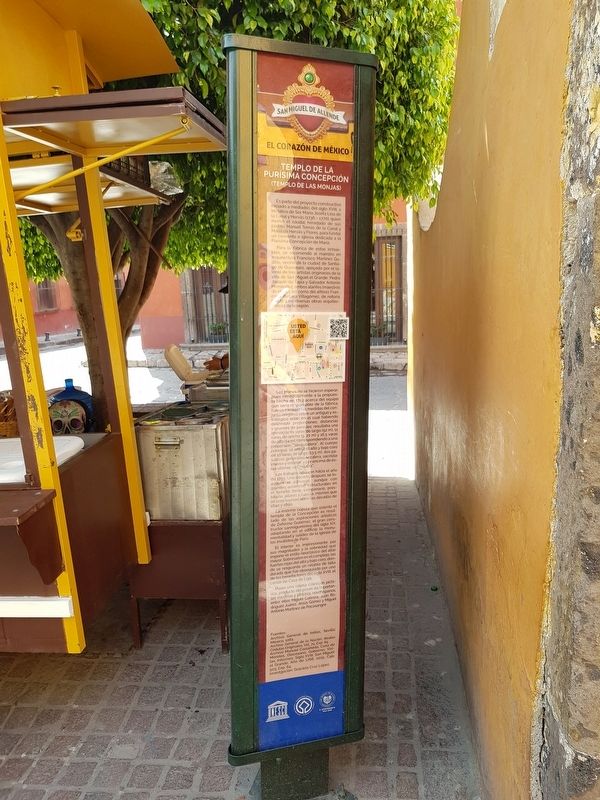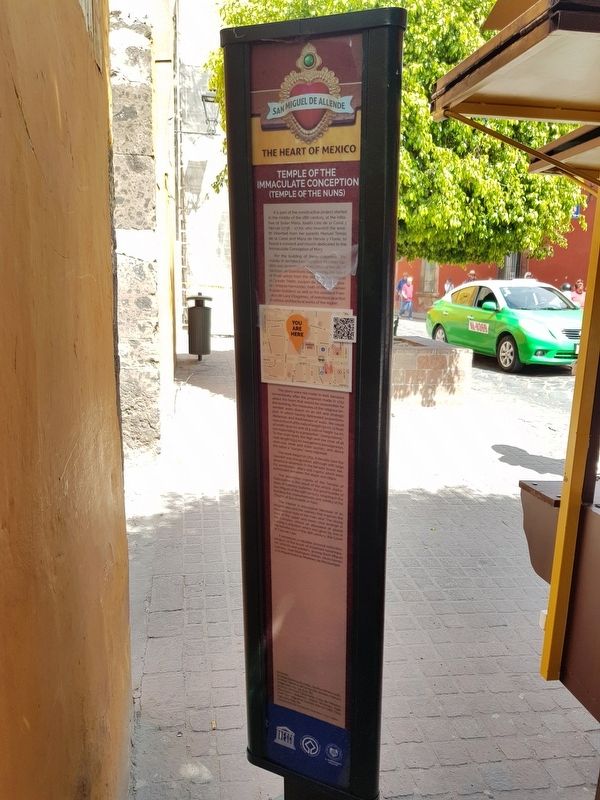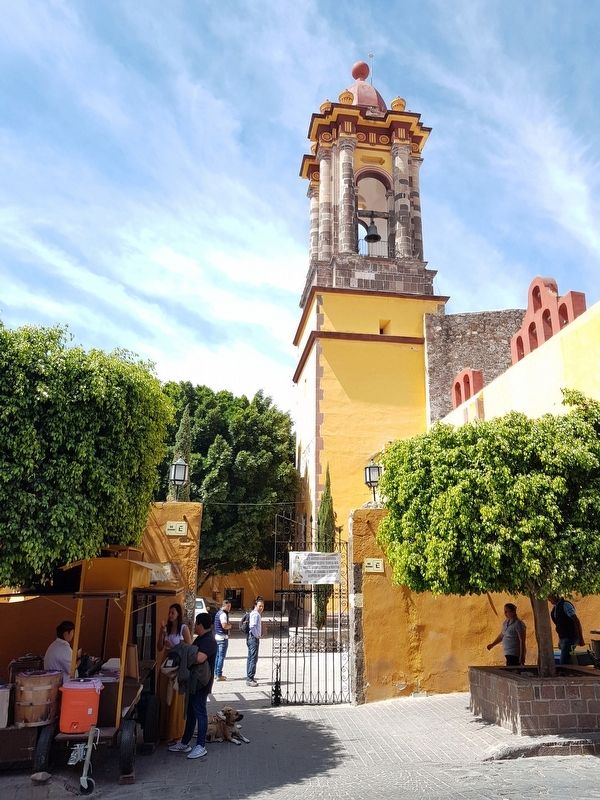San Miguel de Allende, Guanajuato, Mexico — The Central Highlands (North America)
Temple of the Immaculate Conception
(Temple of the Nuns)
— San Miguel de Allende - El Corazón de México —
(Templo de las Monjas)
Es parte del proyecto constructive iniciado a mediados del siglo XVIII, a iniciativa de Sor María Josefa Lina de la Canal y Hervás (1736-1770), quien invirtió el caudal heredado de sus padres Manuel Tomás de la Canal y María de Hervás y Flores, para fundar un convento e iglesia dedicada a la Purísima Concepción de María.
Para la fábrica de estos inmuebles, se recomendó al maestro en arquitectura Francisco Martínez Gudiño, vecino de la ciudad de Santiago de Querétaro; apoyado por el talento de tres artistas originarios de la villa de San Miguel el Grande: Pedro Joaquín de Tapia y Salvador Antonio Hernández, ambos alarifes (maestros de obras), así como del alférez Francisco de Lara Villagómez, de notoria práctica en diversas obras arquitectónicas de la región.
Los planes no se hicieron esperar, pues inmediatamente a la propuesta hecha en 1752 acerca del equipo que sería responsable de la fábrica, fueron trazadas las medidas del conjunto religioso sobre un antiguo y estratégico solar, en el cual habiendo delineado proporciones, distancias y gruesos de paredes, resultaba una iglesia de 61 varas de largo (52 m), 11 varas de ancho (9.21 m) y 16.5 varas de alto (14 m), correspondiendo a una proporción “sexquilátera”. Al cuerpo principal, se anexó el alto y bajo coro de 16 varas de largo (13.5 m), dos pasadizos generales, escalera, sacristía interior y exterior, y por encimas de éstas últimas, un “niñado”.
Los trabajos iniciaron hacia el año de 1755. Una década después se inauguró el convento, aunque con grandes ausencias estructurales en el templo: torre, campanario, presbiterio, altares y cúpula, mismos que se concluyeron entre las décadas de 1840 y 1890.
La enorme cúpula que ostenta el templo de la Concepción es resultado des aspiraciones artísticas de Zeferino Gutiérrez, el gran constructor sanmiguelense del siglo XIX, adaptando en el edificio la monumentalidad y solidez de la iglesia de los Inválidos de París.
El interior es impresionante por sus magnitudes y la sobriedad que impone el estilo neoclásico del altar mayor. Sobresalen en el complejo, las fuertes rejas del alto y bajo coro, donde se resguarda un retablo de talla dorada que fue obsequiado por uno de los benefactores del siglo XVIII, el conde de Casa de Loja.
Posee una valiosa colección pictórica, producto del pincel de importantes escuelas y pintores novohispanos, entre ellos Miguel Cabrera, Juan Rodríguez
Juárez, Jesús Gómez y Miguel Antonio Martínez de Pocasangre.
Fuentes:
Archivo General de Indias, Sevilla; México, 1061.
Archivo General de la Nación, Real Cédulas Originales, Vol. 74, Exp. 65.
Archivo Manuel Castañeda, Casa de Morelos, Diocesano, Gobierno, Visitas, Informes, Siglo XVIII, San Miguel el Grande, Año de 1766, 0215, Caja 503, Exp. 64.
Investigación: Graciela Cruz López
Temple of the Immaculate Conception
(Temple of the Nuns)
It is part of the constructive project started in the middle of the 18th century, at the initiative of Sister María Josefa Lina de la Canal y Hervás (1736-1770), who invested the wealth inherited from her parents Manuel Tomás de la Canal and María de Hervás y Flores, to found a convent and church dedicated to the Immaculate Conception of Mary.
For the building of these properties, the master in Architecture Francisco Martínez Gudiño was recommended neighbor of the city of Santiago de Querétaro; supported by the talent of three artists from the villa of San Miguel el Grande: Pedro Joaquín de Tapia and Salvador Antonio Hernández, both of them bremen (master builders) as well as the assistant Francisco de Lara Villagómez, of notorious practice in various architectural works of the region.
The plans were not made to wait, because immediately after
the proposal made in 1752 about the team that would be responsible for the building, the measures of the religious ensemble were drawn on an old and strategic plot, in which having delineated proportions, distances and thicknesses of walls, the result was a church of 61 rods of length (52 m), 11 Rods of width (9.21 m) and 16.5 rods of height (14 m), corresponding to a proportion “sixequilateral.” To the main body the high and low choir of 16 rods length (13.5 m), two general passageways, staircase, inner and outer sacristy, and above the latter a “nursery” were adjoined.
The work began in 1755. A decade later the conven was inaugurated, although with large structural absences in the temple; tower, belfry, presbytery, altars and cupola, which were concluded between the 1840s and 1890s.
The enormous cupola of the Temple of Conception is the result of the artistic aspirations of Zeferino Gutiérrez, the great builder of San Miguel of the 19th century, adapting in the building the monumentality and solidity of the Church of the Invalids of Paris.
The interior is impressive because of its magnitudes and the sobriety that imposes the neoclassical style of the main altar. The strong bars of the upper and lower choir emerge in the complex, where an altarpiece of gilded carving is shielded, which was given by one of the benefactors of the 18th century, the Count of Casa de Loja.
It possesses a valuable pictorial collection, product of the brush of important novohispanic school and painters, among them Miguel Cabrera, Juan Rodríguez Juárez, Jesús Gómez and Miguel Antonio Martínez de Pocasange.
Sources repeated in Spanish
Topics. This historical marker is listed in these topic lists: Churches & Religion • Colonial Era • Man-Made Features. A significant historical year for this entry is 1752.
Location. 20° 54.872′ N, 100° 44.72′ W. Marker is in San Miguel de Allende, Guanajuato. Marker is at the intersection of Dr. Ignacio Hernández Macías and Canal, on the right when traveling south on Dr. Ignacio Hernández Macías. Touch for map. Marker is in this post office area: San Miguel de Allende GTO 37700, Mexico. Touch for directions.
Other nearby markers. At least 8 other markers are within walking distance of this marker. The Remains of the Insurgents (a few steps from this marker); Ignacio Ramírez “El Nigromante” Cultural Center (within shouting distance of this marker); José María de Jesús Diez de Sollano y Dávalos (within shouting distance of this marker); Carmen Masip Echazarreta (within shouting distance of this marker); a different marker also named Temple of the Immaculate Conception (within shouting distance of this marker); House of Juan Umarán (about 90 meters away, measured in a direct line); The Francisco I. Madero Fountain (about 120 meters away); Narciso María Loreto de la Canal (about 120 meters away). Touch for a list and map of all markers in San Miguel de Allende.
Credits. This page was last revised on September 1, 2020. It was originally submitted on April 7, 2019, by J. Makali Bruton of Accra, Ghana. This page has been viewed 113 times since then and 12 times this year. Photos: 1, 2, 3. submitted on April 7, 2019, by J. Makali Bruton of Accra, Ghana.


